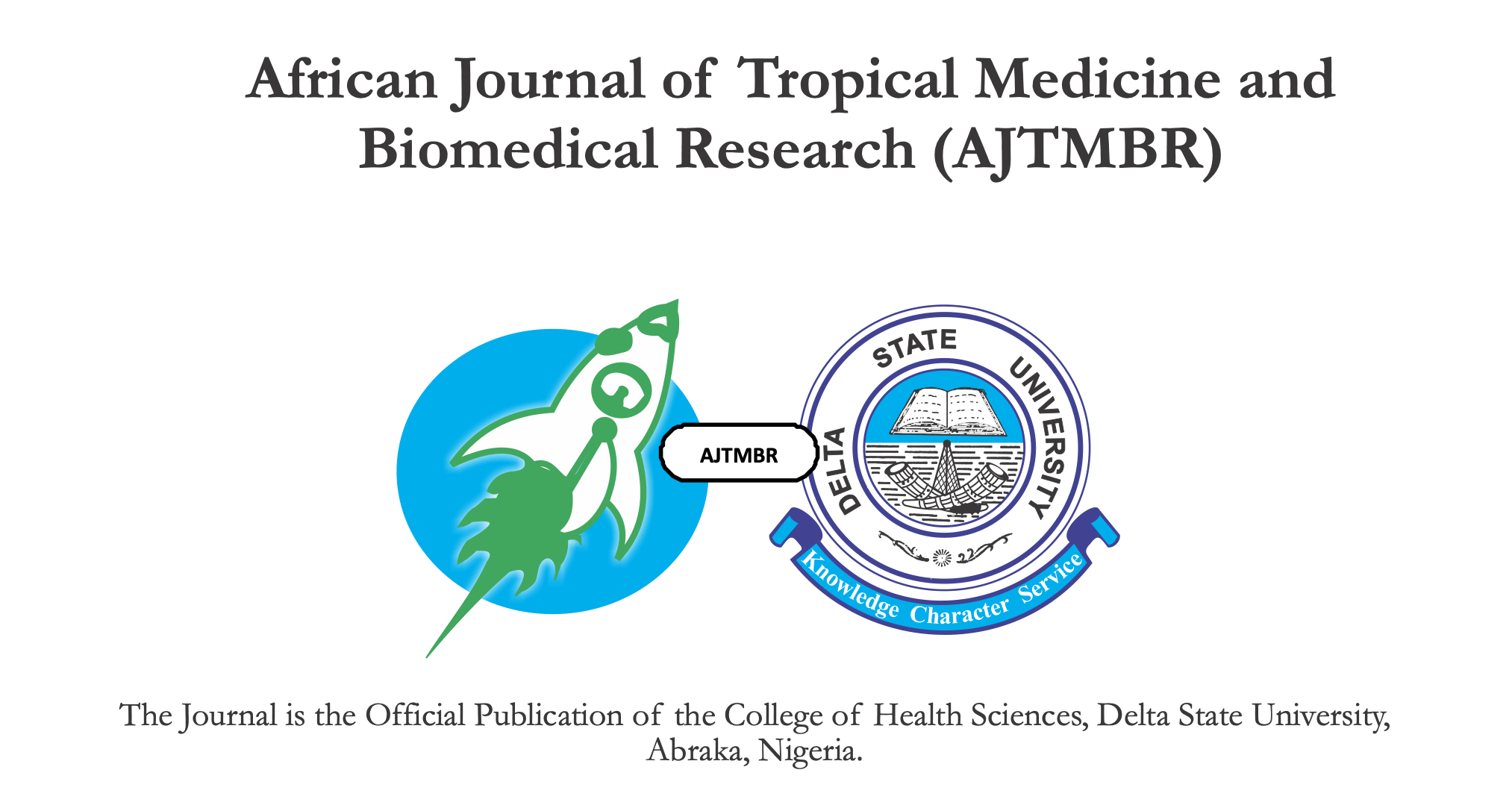ASSESSING RELIABILITY OF CARD AGGLUTINATION TEST FOR TRYPANOSOMIASIS IN SCREENING GAMBIAN SLEEPING SICKNESS AT ABRAKA ENDEMIC FOCUS
Abstract
Introduction: Human African trypanosomiasis (HAT) is one of the neglected tropical diseases. It is endemic in Abraka, south south , Nigeria . Clinical features of this disease are not sufficiently specific for diagnosis of HAT; a definition diagnosis relies on laboratory examination. The card agglutination test for trypanosomiasis (CATT) is a useful fast practical serological test for HAT screening in endemic areas. There are indications that CATT results may be misleading since it is not 100% sensitive. The objective of the study was to evaluate the reliability of CATT test in Abraka sleeping sickness endemic focus.
Method: This study was carried out in Oria-Abraka for about two years from march 2013. A total of 254 consenting individuals were screened with CATT reagent. All sero-positive individuals were further subdivided into mild, moderate and severely positive. Detailed clinical examination and parasitological evaluation of blood, csf and aspirates of lymph node, of all seropositive individuals were done to confirm the diagnosis of HAT. 26 seropositive were followed-up for 24months and one for 3months.
Results: 27 of the 254 consenting individual tested positive to CATT test, giving a seropositivity of 10.6%. All the seropositive individuals were parasitologically negative after series of parasitological examinations over 24months period. They were all also positive to malaria parasite test.
Conclusion:Card Agglutination Test for Trypanosomiasis is not specific enough for screening for trypanosome brucei gambiense infestation within the Abraka sleeping sickness endemic focus
References
C.Isaac, O.P.G. Nmorsi, I.B.Igbinosa, D.O. Umukoro, C.I.Ikaraoha And N.C.D. Ukwandu; Trace Metal Profiles Of Nigerians With Trypanosome Brucei Gambiense-Infection, Journal Of Parasitology And Vector Biology. Vol.3 (1) Pp. 8-11, January 2011.
Bisoffi, Z., Beltrame, A., Monteiro, G., Et Al. African Trypanosomiasis Gambiense, Italy. Emerg. Infect. Dis. 2005; 11: 1745-1747.
C.Isaac, O.P.G. Nmorsi, I.B.Igbinosa, D.O. Umukoro; Vitamins (A,B1 and C) Status Of Nigerians With Trypanosome Brucei Gambiense-Infection, Reviews In Infection. Rif 1(4):188-191 (2010)
Harrisons Principles Of Internal Medicine Ninth Edition, Section 14, Page 876-879. 5. Chappuis F, Pittet A, Bovier PA, Et Al. Field
Evaluation Of The CATT/Trypanosoma Brucei Gambiense On Blood-Impregnated Filter Papers For Diagnosis Of Human African Trypanosomiasis In Southern
Sudan. Trop Med Int Health 2002; 7: 942-948 6. Noireau F, Forcebarge P, Cattand P. Evaluation of Testryp CATT applied to samples of dried blood for the diagnosis of sleeping sickness. Bull World Health Organ 1991; 69: 607-608.
Magnus E, Vervoort T, Van Meirvenne N. A card agglutination test with stained trypanosomes (CATT) for the serological diagnosis of T.b. Gambiense trypanosomiasis. Ann. Soc. Belge Med. Trop. 1978; 58: 169- 176.
Penchenier L, Grebaut P, Njokou F, Eboo Eyenga V, Buscher P. Evaluation of LATEX/T.b.gambiense for mass screening of Trypanosoma brucei gambiense sleeping sickness in central Africa. Acta Trop. 2003; 85: 31-37
Truc P, Lejon V, Magnus E, et al. Evaluation of the micro-CATT, CATT/Trypanosoma brucei gambiense, and LATEX/T b gambiense methods for serodiagnosis and surveillance of human African trypanosomiasis in west and central Africa. Bull World Health Organ Pubmed
; 80: 882-886.
WHO. Control and surveillance of African trypanosomiasis. Geneva: World Health Organization, 1998.
Lutumba P, Robays J, Miaka C, et al. The efficiency of different detection strategies of human African trypanosomiasis by T. B. Gambiense. Trop Med Int Health 2005; 10: 347-356.
C.isaac, o.p.g. Nmorsi, i.b.igbinosa, d.o. Umukoro, imarenezor .e.p.k., ihimire .i.g and akinboyeku. A.w.; interleukin (il)-10 and tumor necrosis factor-alpha (tnf-α); profiles of Nigerians with trypanosome brucei
gambiense infection. Annals of biological research, 2010,1(2):62-67
Checchi F, Filipe JA, Haydon DT, Chandramohan D, Chappuis F. Estimates of the duration of the early and late stage of gambiense sleeping sickness. BMC Infect.
Dis. 2008; 8: 16
Active transmission of trypanosome brucei www.ajol.infor gambiense Dutton vol.3, no 2 (2008)
Dukes P, Gibson WC, Gashumba JK, et al. Absence of the litat 1·3 (CATT antigen) gene in Trypanosoma brucei gambiense
Noireau F, Lemesre JL, Nzoukoudi MY, Louembet MT, Gouteux JPF, Frezil JL. Serodiagnosis of sleeping sickness in the Republic of the Congo: comparison of
indirect immunofluorescent antibody test and card agglutination test. Trans. R. Soc. Trop. Med. Hyg. 1988; 82: 237-240.
Lejon, V., Buscher, P., Magnus, E., Moons, A., Wouters, I. And Van Meirvenne, N. A semi-quantitative ELISA for detection of Trypanosoma brucei gambiense specific
antibodies in serum and cerebrospinal fluid of sleeping sickness patients. Acta Trop. 1998; 69: 151-164.
Truc P, Lejon V, Magnus E, et al. Evaluation of the micro-CATT, CATT/Trypanosoma brucei gambiense, and LATEX/T b gambiense methods for serodiagnosis and surveillance of human African trypanosomiasis in west and central Africa. Bull World Health Organ 2002; 80: 882-886.
WHO. Control and surveillance of African trypanosomiasis. Geneva: World Health Organization, 1998.

Downloads
Published
Issue
Section
License

This work is licensed under a Creative Commons Attribution-NoDerivatives 4.0 International License.
Key Terms:
- Attribution: You must give appropriate credit to the original creator.
- NonCommercial: You may not use the material for commercial purposes.
- ShareAlike: If you remix, transform, or build upon the material, you must distribute your contributions under the same license as the original.
- No additional restrictions: You may not apply legal terms or technological measures that legally restrict others from doing anything the license permits.
For full details, please review the Complete License Terms.



